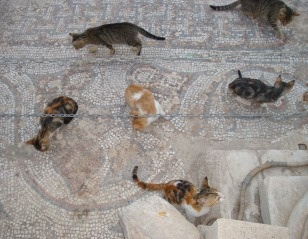Turkey’s most extensive archaeological site
Almost 2000 years ago in 54 AD St Paul fell foul of the Ephesians and caused a riot during the course of his third missionary journey. The “good news” he had to impart didn’t go down at all well with his audience, particularly the local silversmiths who earned a fortune turning out statuettes of the city’s patron goddess Artemis for visitors to the annual festival.
Their reaction was not, perhaps, all that surprising. St Paul, after all, was advocating that they turn their back on a religion that had served them well during the years in which Ephesus had grown into the second largest city of the ancient world, a city whose inhabitants lived in considerable pomp amid marble temples, libraries and public fountains.
St Paul got away with living in Ephesus for three years but eventually his opponents had had enough of his lectures. The riot broke out in the theatre with the irate locals yelling “Great is Artemis of the Ephesians”, and shortly afterwards St Paul left town with his tail between his legs.
Today Ephesus, like Troy, is one of those places that everybody has heard about. But whereas the remains of Troy are less than overwhelming to the casual visitor, those of Ephesus defy anyone to be unimpressed.
This is partly because of the sheer extent of the ruins and partly because of how much still stands above ground, Ephesus being one of those fortunate towns in archaeological terms that was abandoned rather than being built over time and time again.
Backstory
Once much closer to the sea than it is today, the site of Ephesus moved several times over history.
The orginal town grew up in the area around where the scant remains of the great Temple of Artemis that was once one of the Seven Wonders of the Ancient World was later built. A colourful story tells how a Greek oracle advised the would-be founder of the city, Androclus of Athens, to found his new city on a site indicated by a fish and boar. In due course Androclus was lunching with some fishermen by the mouth of the Çayster river when a fish jumped out of the pan, somehow managing to take with it a coal which set fire to the surrounding bush. This caused a boar to run out in panic. Its death provided the cue for building work to begin nearby.
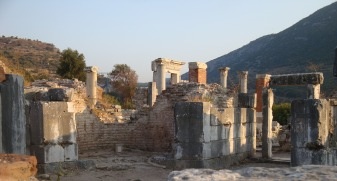 In about 600 BC King Croesus of Lydia attacked and destroyed the first Ephesus, forcing the inhabitants to relocate further inland.
In about 600 BC King Croesus of Lydia attacked and destroyed the first Ephesus, forcing the inhabitants to relocate further inland.
The new city prospered on trade until slowly but surely its harbour started to silt up, causing a third move to the site now occupied by the Roman remains. For some time this solved the problem, but eventually yet more silt began to eat away at access to the new harbour.
Huge efforts were made to dredge and divert the river but to no avail. By the sixth century when the Byzantine Emperor Justinian wanted to build a shrine for St John the Evangelist he decided to site it on Ayasoluk Hill in the heart of what is now Selçuk.
Slowly the old city was abandoned in favour of the new site, a happy chance for history lovers since Ephesus was left to await its rebirth in the age of tourism.
Around the site
The main problem with Ephesus is that the site is too popular for its own good, especially on the days when a cruise ship is docked in Kuşadası. However, given that at least 250,000 people are thought to have been living here when St Paul visited during the city’s heyday the streets would always have been pretty crowded. The trick is to imagine the other tourists as ancient Romans, the cacophony of different languages being tossed about by the guides an echo of the days when this was a port city whose harbour would have reverberated with the sound of voices from all around the Mediterranean.
Unlike most classical sites, Ephesus is enormous, so it pays to plan a visit carefully. There are two entrances, one much closer to Selçuk than the other. On the other hand Selçuk hoteliers can usually be relied upon to give you a lift in which case you might want to consider getting dropped off at the more distant southerly entrance so that you can walk downhill through the site and leave via the exit nearest to town when you’ve finished exploring.
Ephesus is too large to be able to see everything on one visit but these are the most unmissable highlights, all of them in the lower town.
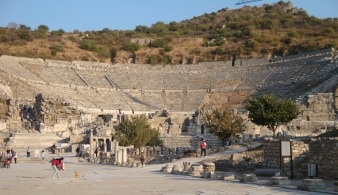 Great Theatre
Great Theatre
The single best known structure at Ephesus must be the enormous tiered theatre that was designed in the first century to seat 25,000 people. It has since been restored so that it can be used for concerts during the International İzmir Festival every autumn. Despite occasional complaints about this it’s surely a better use for the theatre than was made of it during the latter days of the Roman era when gladiators are believed to have battled wild animals here.
Library of Celsus
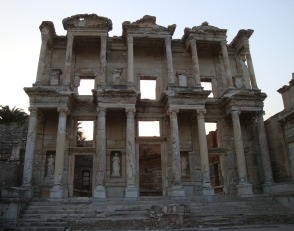
The best-known image of Ephesus is not of the theatre (they are, after all, a dime a dozen in this part of the world) but of the extraordinary statue-studded Library of Celsus, reconstructed in the 1970s so that it still stands to its original impressive height.
Erected in 114, the library once had space for some 12,000 scrolls shelved in niches specially designed to protect them from humidity. Its façade was adorned with images of the personifications of Goodness, Knowledge, Wisdom and Thought.
Agora
Once the heart of Ephesus’s frenetic business life, the agora is a large square surrounded by colonnaded streets, some of them still displaying the ruts carved into the marble flagstones by cart traffic. On display here are some fine carvings of the gladiators who once fought at Ephesus.
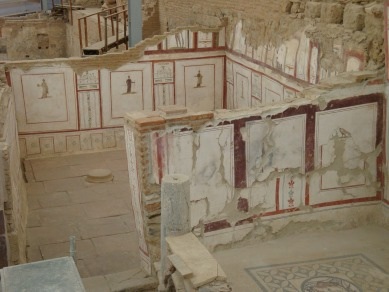 Terraced Houses (Yamaç Evleri)
Terraced Houses (Yamaç Evleri)
For many visitors the most memorable part of the site may well be the Terraced Houses which stand in places to the height of two floors and show off the style in which wealthier people would have lived, with colourful frescoes decorating the walls and mosaics carpeting the floors.
Nowhere else other than perhaps at Herculaneum in Italy can you get such a strong sense of what life might have been like for ordinary citizens in Roman times. Some people are put off visiting by the additional entrance fee but it’s worth every kuruş, especially since the extra charge keeps the crowds at bay.
Communal toilets
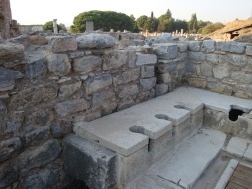
Guaranteed to bring a smile to the lips of bored children, the public toilets off Curetes Way offer a rare glimpse into a world less squeamish than our own about bodily functions, a world in which people seemingly didn’t bat an eyelid about sitting down side by side to relieve themselves.
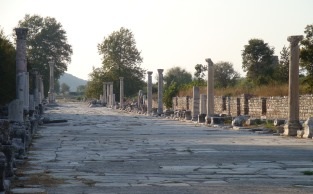 Harbour Street
Harbour Street
There’s something especially evocative about being to walk along a flagstoned street in the literal footsteps of the Romans, which is what you can do along Harbour Street, once the people-packed İstiklal Caddesi of Ephesus with colonnades alongside the road providing protection for shoppers browsing the fashionable shops on either side.
Transport info
The nearest airport to Ephesus is in İzmir.
From İzmir bus station there are regular buses to Selçuk and Kuşadası, the two most obvious bases for a visit. You can easily walk or cycle from Selçuk to Ephesus.
There are also hourly dolmuşes from Selçuk to Şirince, an alternative hillside village that can be used as a base.
Infrequent dolmuşes link Selçuk with Ephesus so you won’t have to walk back if you’re feeling exhausted.

